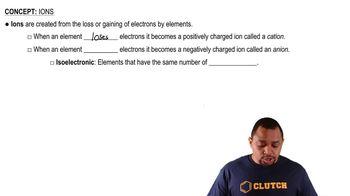Textbook Question
Using only the periodic table, arrange each set of atoms in order of increasing radius: (a) Cs, Se, Te (b) S, Si, Sr (c) P, Po, Pb.
 Verified step by step guidance
Verified step by step guidance



Using only the periodic table, arrange each set of atoms in order of increasing radius: (a) Cs, Se, Te (b) S, Si, Sr (c) P, Po, Pb.
Identify each statement as true or false: (a) Cations are larger than their corresponding neutral atoms.
Identify each statement as true or false: (b) Li+ is smaller than Li.
Use data from Appendix C, Figure 7.10, and Figure 7.12 to calculate the lattice energy of RbCl.
Which neutral atom is isoelectronic with each of the following ions? Ga3+, Zr4+, Mn7+, I−, Pb2+.